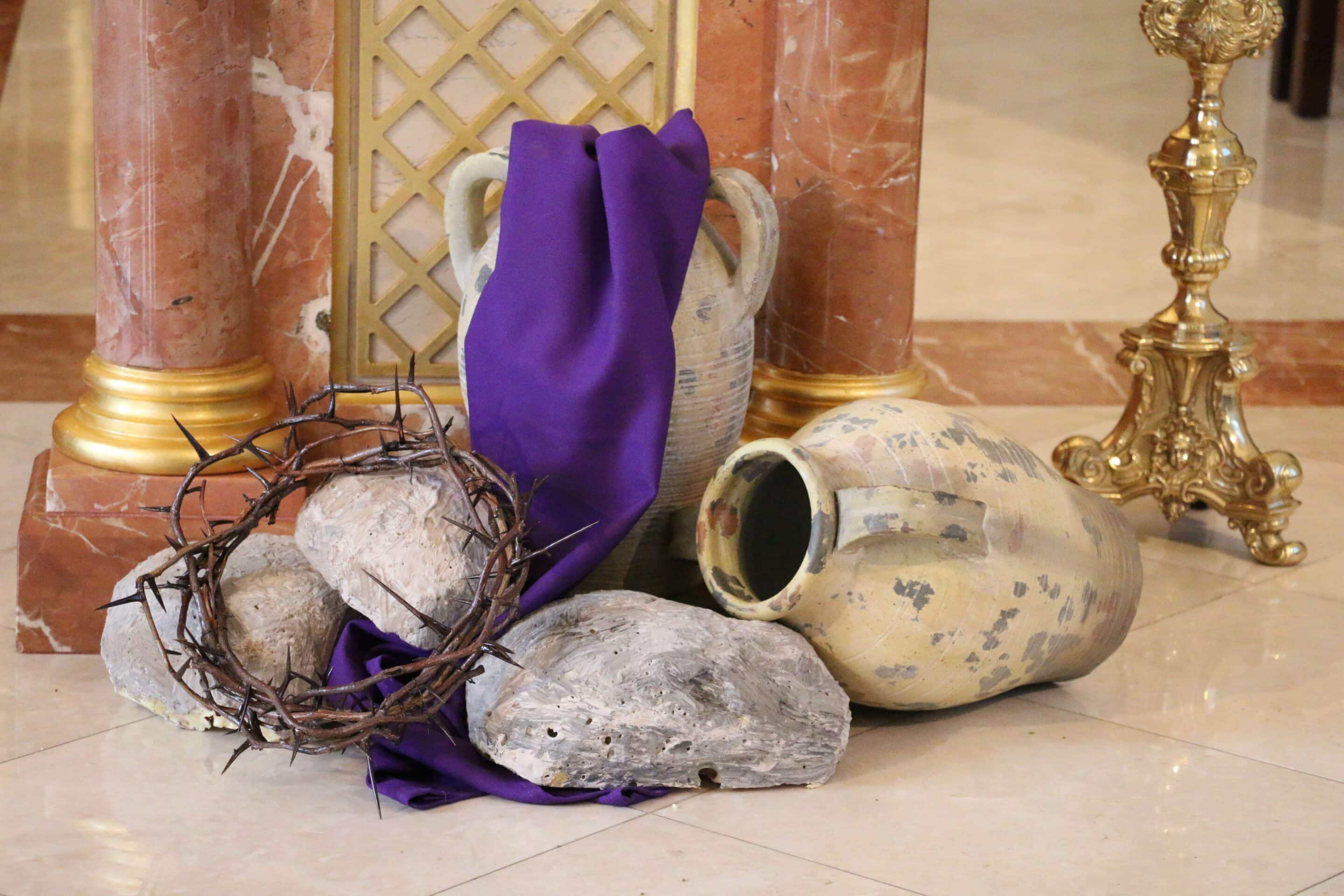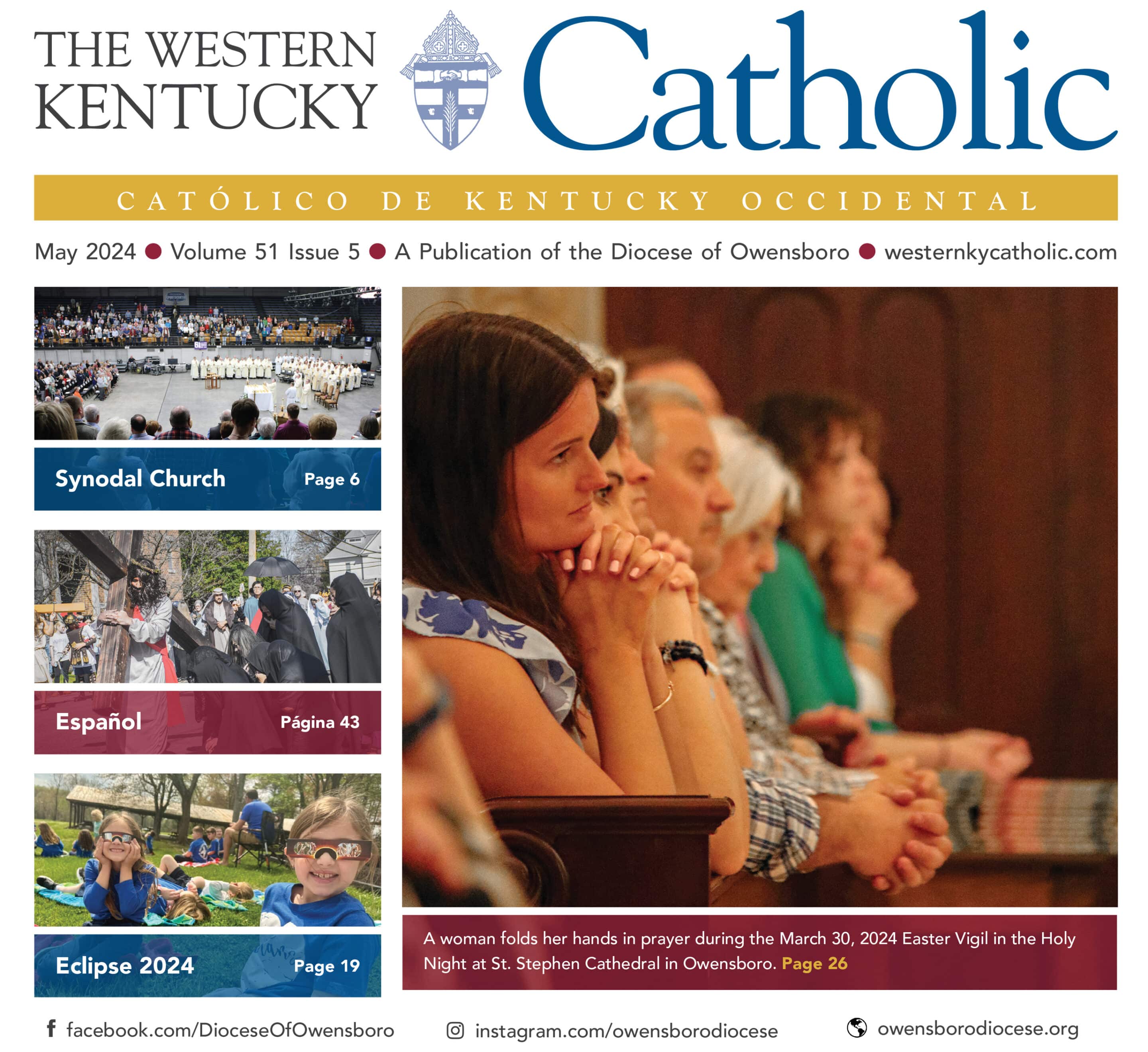
A display of Lent-themed items are seen in the sanctuary of St. Stephen Cathedral on Ash Wednesday, Feb. 14, 2024. ELIZABETH WONG BARNSTEAD | WKC
Source & Summit: Third Sunday of Lent
(The faithful) taking part in the Eucharistic sacrifice, which is the source and summit of the whole Christian life, offer the Divine Victim to God, and themselves along with it.
-The Second Vatican Council fathers in Lumen Gentium, #11
Source & Summit is a feature of The Western Kentucky Catholic online, celebrating the National Eucharistic Revival: Year of Parish Revival. Intended to help Catholics of our parishes to probe the riches of our liturgical year and celebrate the liturgy well, the column will always start with the Bible readings for the Mass of the Day to help us reflect on, and help to “unpack” and expand our experiences at liturgy into the domestic church (the home) and the workplace.
Sunday reflections will be based on the Lord’s Day, the Liturgy, the Eucharist, and, occasionally, community.
March 3, 2024:
Third Sunday of Lent
For Year B readings: https://bible.usccb.org/bible/readings/030324-YearB.cfm
Ex 20:1-17
Psalm 19:8, 9, 10, 11
1 Cor 1:22-25
Jn 2:13-25
The first reading from Exodus proclaims the terms of God’s covenant with the Hebrew nation… an absolute insistence on serving only one God by putting away all idols, honoring God’s holy name, and observing the Sabbath as God’s day to accept the human rest needed for healthy bodies and spirits. The other “half” of the covenant’s demands govern the honor, respect, and care we owe one another, our neighbors, our brothers and sisters in Christ. Then the Gospel presents the well-known story of Jesus cleansing the Temple, the “house of God.” Unlike the synoptics which place this event at the beginning of Holy Week as an action so outrageous to Jewish authorities that it effectively signs Jesus’ death warrant, John places this event very early in Jesus’ ministry, immediately after the wedding feast of Cana. Thus for John, this cleansing links the temple as the sacred “place” of God, Jesus himself as the very presence of God, and the community of disciples Jesus will form, a community that in effect replaces the Temple because its members receive their very life from communion with Jesus the Vine and in whom the Trinity dwells, as he promises in the Last Supper discourse. Just as Jesus will give a new commandment (Love one another as I have loved you) to fulfill the commandments of the Old Testament, he fulfills all that the Temple foreshadowed—the divine Presence among God’s people. Wondrous signs and human wisdom can’t grasp this truth of Jesus as God Incarnate. Yet for the eyes of faith, he is indeed the Power of God and the Wisdom of God – inviting us beyond all laws to the Law-Giver, inviting us beyond all buildings and ceremonies to offer “worship in spirit and in truth” to the God whose loving presence permeates the universe. Am I willing this coming week to recall frequently that I am a Temple of God… that despite death, I am destined to live forever in the heavenly Jerusalem?
For parishes with RCIA programs using Year A readings: https://bible.usccb.org/bible/readings/030324-YearA.cfm
Ex 17:3-7
Psalm 95:1-2, 6-7, 8-9
Rom 5:1-2, 5-8
Jn 4:5-42
As we continue to pray with the Elect preparing for Baptism at the Easter Vigil, the church offers us the opportunity to pray with the liturgical readings of Year A that center on Living Water.
First, we meet the thirsty Israelites in the desert, so like us in complaining and looking back to “the good old days” through rose-colored glasses, conveniently forgetting that they were enslaved, often overworked, hungry, and subject to persecution and even death by their Egyptian overlords. In an attitude so common today, when things went wrong in the desert, they looked for someone to blame and chose Moses to scapegoat. But then as now, God was merciful and, thanks to Moses’ prayer, gave the people relief through the miraculous “water from the rock…”
Continuing with a focus on water, the Church offers the famous story of the Samaritan woman… and probably the detail for which the story is most noted, thanks to centuries of preaching the story as an example of Jesus’ forgiveness of loose morals, is that the woman had five husbands and was living with someone to whom she wasn’t married. But is there more to this story? Indeed, yes! First of all, in the Jewish tradition, wells were often places of betrothals, and there are strong hints of spousal symbolism here. Certainly, this woman was a triple outcast to traditional Jewish rabbis – she was a woman, a hated Samaritan, and was in an irregular (to say the least!) relationship. But was this last point her fault? Was she in fact promiscuous? Scholars point out that unlike Roman women, neither Jewish nor Samaritan women had the power to divorce husbands. Thus her status would not have been her choice; perhaps she’d been unable to have children, and so was frequently discarded or abandoned. We can imagine that at a certain point, no one else would marry her, so for survival’s sake, she accepted her current “live-in” relationship. And yet it is with this woman that Jesus chose to have the longest and most theologically sophisticated conversation of any in all four gospels. Further, could it be that, having experienced Jesus’ compassion and realizing she’s fully known for the first time in her life, she’s not so much “changing the subject” to avoid discussing her checkered past as she suddenly feels free to ask the deep religious questions that have surfaced in her heart during years of ostracism and loneliness? This profound conversation touched Jesus as well – only to this woman (and to the high priest in Mark’s version of Jesus’ trial) did he admit openly that he was the Messiah.
There are so many things we might learn from these water stories… how generous God is even when we don’t deserve it, how universal Jesus’ will to save is, how much he wants a loving relationship with each person, regardless of past mistakes and present circumstances. Will we too, like the Samaritan woman, the Gospel’s first missionary, let Jesus fill us with the living waters of his Spirit? Will we too boldly go to family and friends, neighbors and acquaintances and share what God has done in our lives and try to bring them to Jesus?
-Sr. Cheryl Clemons, OSU
Sr. Cheryl Clemons is an Ursuline Sister of Mount Saint Joseph.
To learn more about the Diocese of Owensboro’s celebration of the National Eucharistic Revival, visit https://owensborodiocese.org/eucharistic-revival/.


